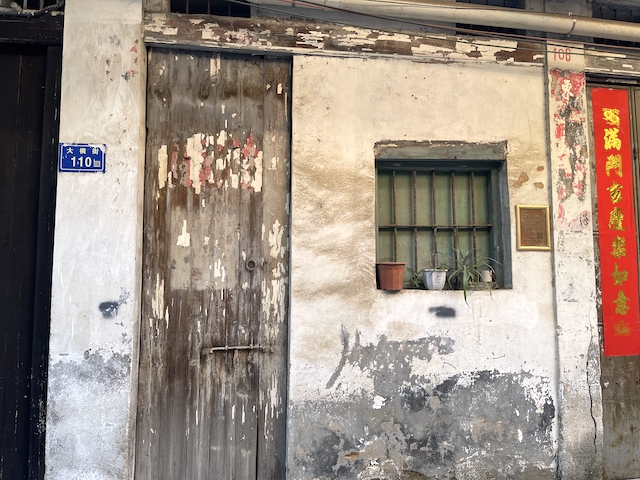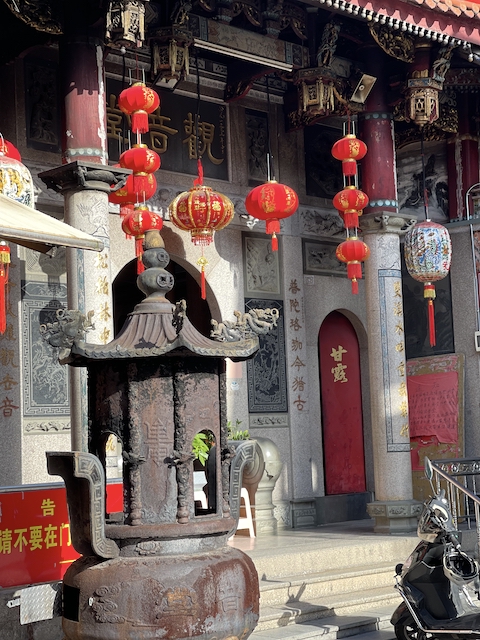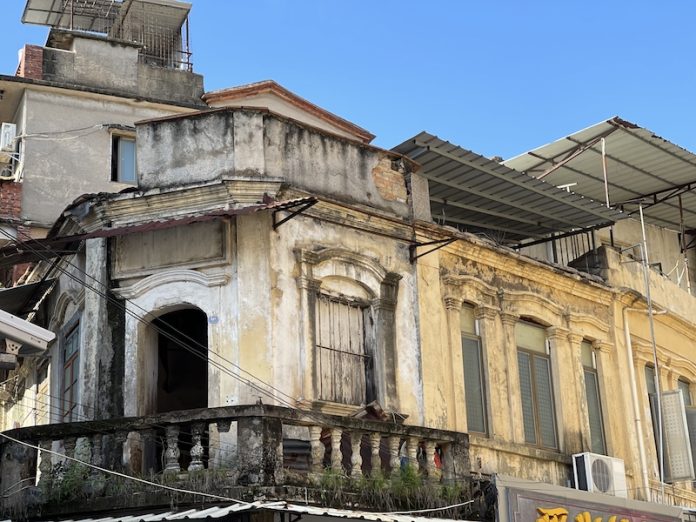With Tongan city’s last ancient street now obsolete, its reconstruction sparks controversy between generations.
Huaping Ye slows down his bicycle speed as he crosses the new asphalt road in Tongan’s city centre. At the intersection, which starts with a rough stone surface, he stops and secures his bike to a rusted iron pipe beside Songbolin street. It was a popular parking method ten years ago, but now it’s antiquated. Mr Ye, who is 58 years old, lived here in his youth.
It only takes 20 seconds to go from a wide road to a narrow street. The moss on the uneven stone steps and the ancient Chinese-style buildings’ walls have become dark.
Across from this intersection are McDonald’s glass windows displaying ice-cream advertisements. Nearby is a busy parking area. The old street is like a bare branch caught among the bright flowers; it does not belong here.
I stood at the junction waiting for Mr Ye. He adjusted his clothes and said in Chinese, “young people rarely come here”.
“Let’s enjoy Songbolin Street today. I hope you wore a pair of comfortable shoes,” he said with a smile. “Compared with the wide road outside, the road here may be annoying.”
As we walked on the uneven stone surface, the loose stones squeaked in response. Three bells rang from the clock tower in the city centre. In the quiet street, the bells ring clearly. It was three o’clock in the afternoon when we began our journey.
“This was originally a lively area,” Mr Ye said. “When my parents and I lived here, it was a commercial street that opened at six in the morning. There were various stores here, and it was packed from morning to night.
“It’s probably awful compared to the new commercial street outside now. If the surrounding old houses hadn’t been demolished, Songbolin Street might not look so deserted, but this street might also be demolished soon.”
He shook his head sadly as he spoke.
Tongan is a city in the Southeast of China, and Songbolin Street is its last historic street. It is dubbed “the last memory” by older residents. In the 2022 Tongan City Development and Reconstruction Plan, the Urban Planning Organisation included this “last memory” in the demolition list.
The street, which has stood proudly for 800 years, as recently as 15 years ago was surrounded by a mix of commercial and residential streets. The residential wooden buildings and stone houses were prominent but the city renovation demolished almost 90 per cent of the old houses. Tongan Population Movement Statistics Report reveals that the residents moved into new apartments, and more than half left for another city.
Shixiang Yu, a worker with the Urban Planning Organisation, told me the street had long been scheduled for demolition.
“Almost all the old houses near here were already demolished,” he said. “In the original plan, Songbolin Street was to have been demolished three years ago. But almost all the old residents disagreed and the reconstruction plan has been delayed repeatedly.”
The plan has now been revived after more than 70 per cent of the city’s young people lobbied the government to demolish the old homes.
“Here is the city’s centre, and the surrounding old houses have been converted into shopping malls and new commercial buildings,” Yu said. “Young people like to come here to eat and shop and say they feel strange when they pass through Songbolin Street. If we demolish this street to build a new shopping mall it may be more convenient for residents.”
Yu pointed to the refurbishment plan on his laptop and clicked on a delicate virtual modelled image showing the location for the food courts and the new shopping area.
But he sighed as he spoke of the street’s history: “Tongan is also my hometown. As a resident, of course I know the historical significance of this street.”
Clicking on a photo of Songbolin Street, he pointed at some completely unrecognisable buildings. “My dad used to bring me here to buy toys when I was a kid. I remember there was a park over there. But from my work perspective, the houses here are too old. It’s not just the aesthetics problems; the safety hazard worries us most.”
Authorities are still monitoring public opinion. Despite the government providing compensation to owners of houses to be demolished, many older residents continue to resist.
The stroll with Mr Ye helped me to understand this opposition. Although many stores were closed, Ye was excited as he described how the street used to be.
“Here was Uncle Li’s house; he sold lanterns. And here was Aunt Chen’s sewing shop. Here was the breakfast shop of Mr Huang; his son was my best friend.” Mr Ye pointed at the different closed doors as he introduced them.
Those shops have already disappeared, leaving only rotten wooden doors and rusted iron windows, and bad smells. A City Planning Organisation sign pasted on a cracked building’s outer wall, reads “Dangerous House, Do Not Approach”.
“The gap between what we see now and before is too large. it’s really hard to imagine how beautiful Songbolin Street used to be in the past,” Ye said as he looked up at the warning sign and the outer wall of the building. There were still some carvings that were popular 30 years ago, but the cracks that covered most of the wall were like dense blood vessels. He shook his head and said: “It’s reasonable why they have to be demolished. The beautiful and delicate houses have become awful now.”

Jingjing Lin owns a house on Songbolin Street but has never lived there. She is 25 years old and works in Shanghai.
“It used to be my grandparents’ house but unfortunately, they are not alive now,” Lin said, “so this old house belongs to me now.”
Lin supported the decision to demolish the old houses on the street. “Why not? Although I haven’t been back these years, I remember that the street was deserted for a long time. Our house was too old. Nobody would willingly live there,” she said. “I think it will be better to build new shopping malls or public facilities there. Reasonable use of such a good location can be a convenience for all residents.”
Lin has almost no memories of the street and has forgotten what the building looks like.
“I just remember that I got a call from the City Planning Organisation three years ago,” she said. “They told me my house might be demolished. The government would compensate us for its demolition. It was good news for me! The compensation would allow me to do more things I want to do.
“Tongan is different from Shanghai, and it needs to speed up its development. Rather than just leaving the house empty, the space can be used to provide residents with better quality of life. This is the only way to show the value of these old houses.
In 2022, the Chinese national land expropriation compensation standard law, when the government requisitions citizens’ land, states they must pay the compensation amount corresponding to the land area. The compensation amount for land acquisition in Tongan City is about 29,000 Yuan (RMB) per square metre. If residents do not accept compensation and choose to keep their land, the government cannot compulsorily expropriate the land.
But Mr Ye does not care about compensation. He stopped walking, took a tissue from his pocket and handed it to me, gesturing for me to wipe my shoes. The moss on the stone road was staining my shoes. The moss had also stained Mr Ye’s shoes but he didn’t care.
“The compensation amounts? I don’t care about that,” he said. “I don’t agree that Songbolin Street be demolished because here are my memories and cultural beliefs.”
As we continued our journey, a Buddhist temple appeared on the street’s left side. Compared with other old houses, the red wooden doors and clean stone pillars of the Buddhist temple were new. The incense burner at the entrance glowed faintly.
“Someone must have come here to pray for blessings not long ago,” Mr Ye said. “Buddhist culture has always been the belief of most people in our city. Although few people live on the street, other citizens still come to this temple to pray and worship every day.”

He remembers that his mother walked here every day to light incense.
“My mother said she was praying for our peace and happiness. It would come true,” he said, and a smile crossed his face. Then he walked to the temple’s door and put his palms together devoutly, closed his eyes and silently made a wish to the gods inside. The aged citizens busy in the temple have no idea what he wished as they light incense or chant sutras. When I closed to the incense burner, the reassuring smell soothed my mind like a warm hand.
As we left the temple we could see that some balconies on the second floor of houses we passed had large gaps, and some stone fences were missing. Only a few rusted steel bars were left exposed, and with time, drooped on the outer walls like the dead branches.
Mr Ye stopped and looked up at an old three-storey building with a warning sign from the Urban Planning Organisation.
“This was my home. We lived here 20 years ago,” he smiled for a moment. “And now? Only my dead father lives here… well, I mean his photo.
“We came here every year to honour him, and he has lived in this house almost all his life. I have many happy memories with my parents in this home.”
Ye added that inside there were also old furniture and decorations from the last century. “Last time, I found my dad’s old collection. They were paintings from the Qing Dynasty.”
Mr Ye sighed. “It’s a pity that I can’t take you in to visit. The house is so dangerous now. It will shake even if one person is climbing the stairs. If you ask me why I moved, this is the reason. We can’t live in a dangerous house all the time.
“If Songbolin Street is really going to be demolished, I don’t know how I can deal with these things; it would be a shame to throw them away. Many objects’ cultural values are beyond measure.”
The building next to Mr Ye’s home was no longer an old building. A coffee shop appeared at the intersection, its exquisite decoration creating a sharp contrast with the old buildings. We had arrived at the end of Songbolin Street.
The clock tower bells rang again – five times to announce it was five o’clock in the afternoon. Young people’s entertainment period was just beginning. The surrounding shopping malls ushered in their busiest period as music, laughter and the sound of traffic spread to Songbolin Street.
Mr Ye turned looked at the long, thin street. When the night gradually enveloped those old buildings, SongBolin Street quietly fell asleep, like an older person. This area is still the city centre, but it’s now a modern city centre for the 21st century.
“See you, “Mr Ye whispered. “I don’t know how many chances I have, but I hope I can often come back home.” Was this the wish he made at the door of the Buddhist temple?
Mr Ye turned walked towards the bright shopping mall. He had to go back to find his bike. When he had parked it earlier, he said to me: “My bike is almost dead; I might change it for a new one. “


